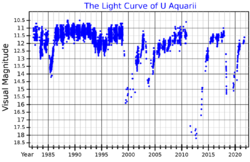Astronomy:U Aquarii
| Observation data Equinox J2000.0]] (ICRS) | |
|---|---|
| Constellation | Aquarius |
| Right ascension | 22h 03m 19.69905s[2] |
| Declination | −16° 37′ 35.2811″[2] |
| Apparent magnitude (V) | 10.6 to 15.9[3] |
| Characteristics | |
| Spectral type | C-Hd[4] |
| U−B color index | 0.07[5] |
| B−V color index | 0.66[5] |
| Variable type | R CrB[3] |
| Astrometry | |
| Radial velocity (Rv) | +89.49±1.54[6] km/s |
| Proper motion (μ) | RA: 2.780[2] mas/yr Dec.: −1.907[2] mas/yr |
| Parallax (π) | 0.0859 ± 0.0222[2] mas |
| Distance | approx. 38,000 ly (approx. 12,000 pc) |
| Details | |
| Mass | 4.5[7] M☉ |
| Surface gravity (log g) | 2.28[7] cgs |
| Temperature | 5,500[5] K |
| Metallicity [Fe/H] | −0.99[7] dex |
| Rotational velocity (v sin i) | 8.4[8] km/s |
| Other designations | |
| Database references | |
| SIMBAD | data |
U Aquarii, abbreviated U Aqr, is a variable star in the equatorial constellation of Aquarius. It is invisible to the naked eye, having an apparent visual magnitude that ranges from 10.6 down to as low as 15.9.[3] Based on parallax measurements, the distance to this star is approximately 38 kly (12 kpc). In 1990, W. A. Lawson and associates provided a distance estimate of 43 kly (13.2 kpc) based on the assumption of a bolometric magnitude of −5.[5] It appears to lie several kiloparsecs below the galactic plane, and thus may belong to an old stellar population.[4]
The stellar classification of this star is C-Hd,[4] and it is classified as a R Coronae Borealis variable.[3] It is a carbon star with a hydrogen-deficient spectra that also shows evidence of s-process elements,[4] including overabundances of strontium and yttrium, but no barium.[10] This combination of properties is exceptionally rare; only one other example has been found as of 2012.[11] The elemental abundances are explained as the result of a single neutron exposure event, which is difficult to reconcile with a conjecture that this may be a post-AGB-type star.[10] In 1999, U Aqr was proposed to be a Thorne-Zytkow object, instead of being a simple R Coronae Borealis variable.[12]
References
- ↑ "Download Data". AAVSO. https://www.aavso.org/data-download.
- ↑ 2.0 2.1 2.2 2.3 2.4 Brown, A. G. A. (2021). "Gaia Early Data Release 3: Summary of the contents and survey properties". Astronomy & Astrophysics 649: A1. doi:10.1051/0004-6361/202039657. Bibcode: 2021A&A...649A...1G. Gaia EDR3 record for this source at VizieR.
- ↑ 3.0 3.1 3.2 3.3 Samus', N. N; Kazarovets, E. V; Durlevich, O. V; Kireeva, N. N; Pastukhova, E. N (2017). "General catalogue of variable stars: Version GCVS 5.1". Astronomy Reports 61 (1): 80. doi:10.1134/S1063772917010085. Bibcode: 2017ARep...61...80S.
- ↑ 4.0 4.1 4.2 4.3 Bond, H. E. et al. (October 1979). "The extraordinary composition of U Aquarii". Astrophysical Journal 233: 205–210. doi:10.1086/157382. Bibcode: 1979ApJ...233..205B.
- ↑ 5.0 5.1 5.2 5.3 Lawson, W. A. et al. (November 1990). "The photometric characteristics of cool hydrogen-deficient carbon stars.". Monthly Notices of the Royal Astronomical Society 247: 91. Bibcode: 1990MNRAS.247...91L.
- ↑ Brown, A. G. A. (August 2018). "Gaia Data Release 2: Summary of the contents and survey properties". Astronomy & Astrophysics 616: A1. doi:10.1051/0004-6361/201833051. Bibcode: 2018A&A...616A...1G. Gaia DR2 record for this source at VizieR.
- ↑ 7.0 7.1 7.2 Anders, F.; Khalatyan, A.; Chiappini, C.; Queiroz, A. B.; Santiago, B. X.; Jordi, C.; Girardi, L.; Brown, A. G. A. et al. (2019). "Photo-astrometric distances, extinctions, and astrophysical parameters for Gaia DR2 stars brighter than G = 18". Astronomy and Astrophysics 628: A94. doi:10.1051/0004-6361/201935765. Bibcode: 2019A&A...628A..94A.
- ↑ Majewski, Steven R.; Schiavon, Ricardo P.; Frinchaboy, Peter M.; Allende Prieto, Carlos; Barkhouser, Robert; Bizyaev, Dmitry; Blank, Basil; Brunner, Sophia et al. (2017). "The Apache Point Observatory Galactic Evolution Experiment (APOGEE)". The Astronomical Journal 154 (3): 94. doi:10.3847/1538-3881/aa784d. Bibcode: 2017AJ....154...94M.
- ↑ "U Aqr". SIMBAD. Centre de données astronomiques de Strasbourg. http://simbad.u-strasbg.fr/simbad/sim-basic?Ident=U+Aqr.
- ↑ 10.0 10.1 Malaney, R. A. (October 1985). "On the nature of the neutron exposure event of U Aquarii". Monthly Notices of the Royal Astronomical Society 216 (3): 743–752. doi:10.1093/mnras/216.3.743. Bibcode: 1985MNRAS.216..743M.
- ↑ Goswami, Aruna (2012). "Spectroscopic characterization of FHLC stars from the Hamburg/ESO survey and a newly found HdC star". in Prugniel, Philippe; Singh, Harinder P.. International Workshop on Stellar Libraries, Proceedings of a conference held 5-9 December, 2011 at University of Delhi, India. 6. p. 189. ISBN 978-81-922926-4-9. Bibcode: 2012ASInC...6..189G.
- ↑ Vanture, Andrew D. et al. (April 1, 1999). "Is U Aquarii a Thorne-Żytkow Object?". The Astrophysical Journal 514 (2): 932–938. doi:10.1086/306956. Bibcode: 1999ApJ...514..932V.
 |


